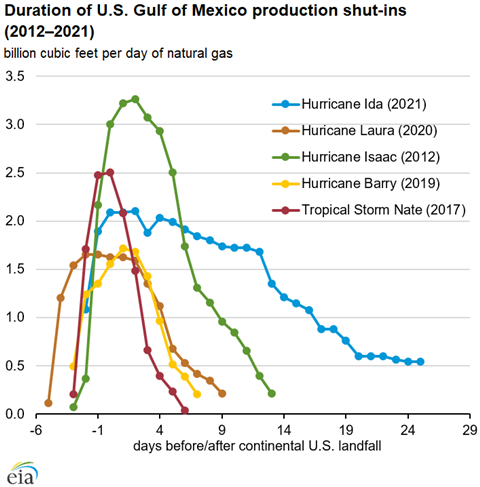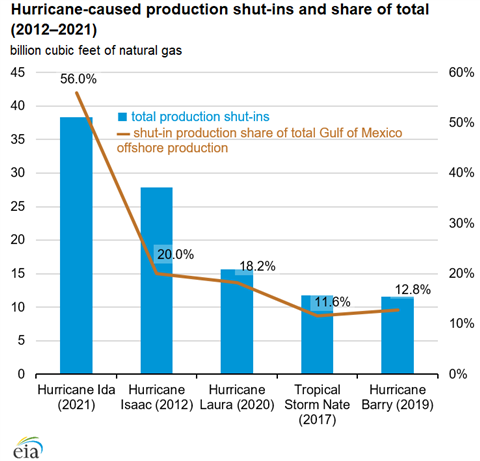Hurricane Ida forced extensive gas shut-ins
28 October 2021

Hurricane Ida, which made landfall on the U.S. Gulf Coast in late August, caused more natural gas production shut-ins than any other hurricane in the last 10 years, the U.S. Energy Information Administration reported.
Hurricane Ida made landfall near Port Fourchon, Louisiana as a Category 4 hurricane, on the anniversary of Hurricane Katrina 16 years earlier. The storm reduced natural gas production by an estimated 38.4 Bcf over 28 days, according to the U.S. Bureau of Safety and Environmental Enforcement. That total is about 56% of the offshore natural gas production and 1.2% of the total U.S. production.
By comparison, Hurricanes Laura in 2020 and Isaac in 2012 shut in 18.2% and 20.0% of offshore natural gas production, respectively, and 0.5% and 1.3% of total U.S. natural gas production, respectively, the EIA reported.
At its peak, Ida forced producers to shut in 2.1 Bcf/d and resulted in the evacuation of 288 production platforms and 11 drilling rigs. Fewer facilities were evacuated in advance of Hurricane Ida than for other recent hurricanes. For example, Hurricane Laura shut-in 299 platforms and 11 rigs, and Hurricane Isaac in 2012 shut-in 509 platforms and 50 rigs, the BSEE reported.
However, the duration of the shut-ins caused by Hurricane Ida, more so than the number of evacuations, contributed to the larger reduction in natural gas production. About 0.2 Bcf/d remained shut in 60 days after Hurricane Ida made landfall.
Hurricane Ida’s direct hit to Port Fourchon had a significant effect on day-to-day operations of Gulf of Mexico offshore oil and natural gas production and the ability of operators to recover after the hurricane.
More than 250 companies that service offshore oil and natural gas production in the Gulf of Mexico have a stake in Port Fourchon. As a result of damage sustained during the storm, 63 offshore platforms remained unmanned for 14 days after the hurricane made landfall, or 11.3% of all platforms in the U.S. Gulf of Mexico.
BSEE reported that 5.5% of platforms were still unmanned 25 days after the hurricane made landfall. BSEE ceased reporting the impacts of Hurricane Ida on September 23, 28 days after the hurricane started to impact production, when Gulf of Mexico offshore natural gas production was still more than 0.5 Bcf/d below pre-hurricane levels.
By comparison, Hurricane Isaac resulted in the second-most days of impaired production when it took 17 days for offshore production to return to pre-hurricane levels.
The impact of Hurricane Ida had long-lasting effects on some operations. Production from Shell Offshore’s West Delta-143 platform was offline for more than 60 days and is not expected to return until the first quarter of 2022. Shell’s West Delta 143 transportation hub, which aggregates production from Shell offshore-operated Mars and Ursa platforms, sustained significant damage, shutting in approximately 220 MMcf/d of natural gas production, the EIA reported.
The Atlantic hurricane season ends November 30, but most hurricane activity takes place in August, September, and October. Hurricane Ida is the only 2021 storm that resulted in BSEE activating its hurricane response team to monitor evacuation and production statistics.

Named storms have winds with maximum speeds above 39 miles per hour. As of October 28, there have been 20 named storms during the 2021 hurricane season. Although 2021 has had more named storms than the 30-year average computed by the National Oceanic and Atmospheric Administration (NOAA), 2021 still lags behind 2020, which had 30 named storms during the Atlantic hurricane season, and broke the previous record set in 2005.





